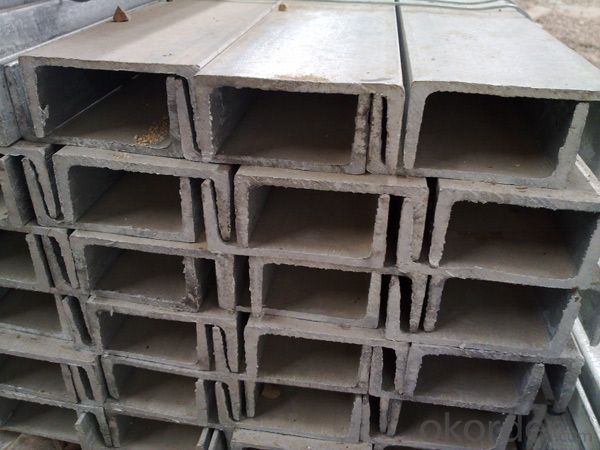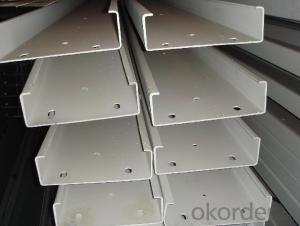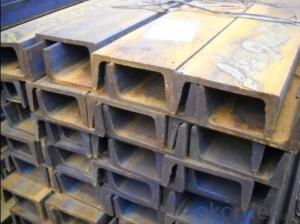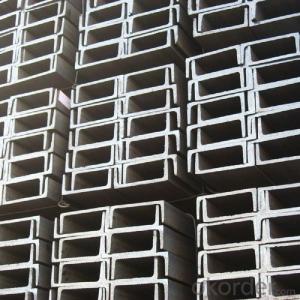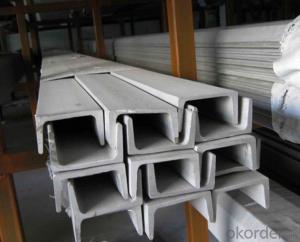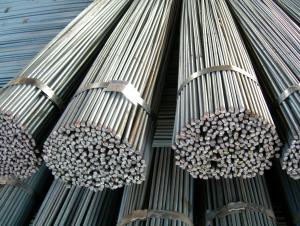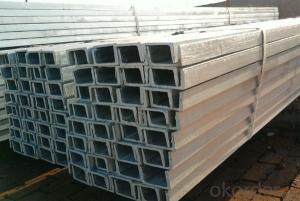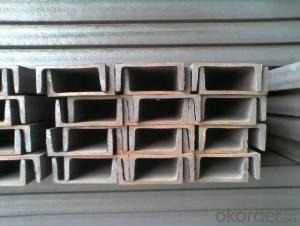U CHANNEL JIS SS400 High Quality Hot Rolled or GB
- Loading Port:
- China Main Port
- Payment Terms:
- TT or LC
- Min Order Qty:
- -
- Supply Capability:
- -
OKorder Service Pledge
OKorder Financial Service
You Might Also Like
Product Description:
OKorder is offering high quality U CHANNEL JIS SS400 High Quality Hot Rolled or GBat great prices with worldwide shipping. Our supplier is a world-class manufacturer of steel, with our products utilized the world over. OKorder annually supplies products to European, North American and Asian markets. We provide quotations within 24 hours of receiving an inquiry and guarantee competitive prices.
Product Applications:
1.The JIS U Channel Steel can be devided into two kinds, namely common channel steel and light channel steel. The sizes of hot rolled common channel steel range from 5# to 40#. Meanwhile, the channel steel can be divided into cold forming sectional equal channel steel, cold forming sectional unequal channel steel, cold forming inner edge channel steel and outer edge channel steel.
2.The JIS u channel steel is usually used for arch-itechtural structure, and they could be welded in order to support or hang a vari-ety of facilities. They are also usually used in combination with I beam. The channel steel with sizes under 14# is usually applied to construction engineering, as purline, while the channel steel with sizes above 16# is more likely to be used in building vehicle chassis structure and mechanical structure. Furthermore, the channel steel in sizes above 30# are target at building bridge structure, as tension bar.
3.In a word, the channel steel must possess perfect welding property, riveting property and mechanical property and so on.
Product Advantages:
OKorder's U CHANNEL JIS SS400 High Quality Hot Rolled or GBare durable, strong, and resist corrosion.
Main Product Features:
· Premium quality
· Prompt delivery & seaworthy packing (30 days after receiving deposit)
· Corrosion resistance
· Can be recycled and reused
· Mill test certification
· Professional Service
· Competitive pricing
Product Specifications:
Manufacture: Hot rolled
Grade: Q195 – 235
Certificates: ISO, SGS, BV, CIQ
Length: 6m – 12m, as per customer request
Packaging: Export packing, nude packing, bundled
Original Place | Tangshan, China | Brand Name | UINDA |
Standard | JIS G3192 : 1990 | ||
Material Grade | SS490 | ||
Sizes | 50mm to 200mm | ||
Sales Volume/Year | 3000MT | ||
Destination Area | Middle East, Africa, Southeast Asia | ||
2. The sections in details are as followings in the table-1
JIS U CHANNEL | Standard | Sectional | Dimension |
| Mass: |
| (mm) | (mm) | (mm) | (mm) |
|
50x25 | 50 | 25 | 3.0 | 6.00 | 2.37 |
75X40 | 75 | 40 | 3.8 | 7.00 | 5.30 |
75X40 | 75 | 40 | 4.0 | 7.00 | 5.60 |
75X40 | 75 | 40 | 4.5 | 7.00 | 5.85 |
75X40 | 75 | 40 | 5.0 | 7.00 | 6.92 |
|
|
|
|
|
|
100X50 | 100 | 50 | 3.8 | 6.00 | 7.30 |
100X50 | 100 | 50 | 4.2 | 6.00 | 8.03 |
100X50 | 100 | 50 | 4.5 | 7.50 | 8.97 |
100X50 | 100 | 50 | 5.0 | 7.50 | 9.36 |
|
|
|
|
|
|
125X65 | 125 | 65 | 5.2 | 6.80 | 11.66 |
125X65 | 125 | 65 | 5.3 | 6.80 | 12.17 |
125X65 | 125 | 65 | 5.5 | 8.00 | 12.91 |
125X65 | 125 | 65 | 6.0 | 8.00 | 13.40 |
|
|
|
|
|
|
150x75 | 150 | 75 | 5.5 | 7.30 | 14.66 |
150x75 | 150 | 75 | 5.7 | 10.00 | 16.71 |
150x75 | 150 | 75 | 6.0 | 10.00 | 17.90 |
150x75 | 150 | 75 | 6.5 | 10.00 | 18.60 |
150x75 | 150 | 75 | 6.5 | 10.00 | 24.00 |
|
|
|
|
|
|
200X80 | 200 | 80 | 7.5 | 11.00 | 24.60 |
3. The mechanical property of JIS U Channel Steel in the table-2:
Grade | Yield Strength,N/mm² | Extension Strength N/mm² | |||
Thickness of Steel,mm | |||||
≦16 | >16-≦40 | >40-≦100 | >100 | ||
SS490 | ≧285 | ≧275 | ≧255 | ≧245 | 490-610 |
4. The chemical composition of JIS U Channel Steel as per SS490 in the table-3
Grade | Element(%) | |||
C | Mn | P | S | |
SS490 | - | - | ≦0.050 | ≦0.050 |
FAQ:
Q1: Why buy Materials & Equipment from OKorder.com?
A1: All products offered byOKorder.com are carefully selected from China's most reliable manufacturing enterprises. Through its ISO certifications, OKorder.com adheres to the highest standards and a commitment to supply chain safety and customer satisfaction.
Q2: How do we guarantee the quality of our products?
A2: We have established an advanced quality management system which conducts strict quality tests at every step, from raw materials to the final product. At the same time, we provide extensive follow-up service assurances as required.
Q3: The products are invoicing on theoritical weight or on actual weight?
A3: We can do it in both manners, according to the customers' request.
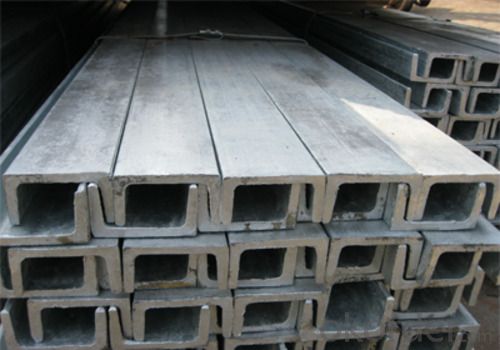
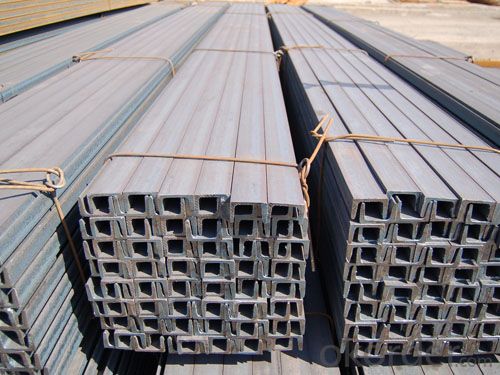
- Q: Can steel channels be used in the aerospace parts manufacturing industry?
- Indeed, the aerospace parts manufacturing industry can employ steel channels. The construction of aircraft structures and components often relies on steel channels, owing to their remarkable attributes of strength, durability, and resistance to deformation. Framing, support structures, and reinforcement for crucial aerospace parts are among the diverse applications that steel channels can fulfill. By providing structural integrity and stability, steel channels play a pivotal role in ensuring the secure and dependable operation of aerospace vehicles. Moreover, the aerospace industry benefits from the ease of fabrication and welding that steel channels offer, rendering them an excellent choice that upholds precision and quality, which are paramount in this field.
- Q: How do steel channels contribute to energy conservation?
- Steel channels contribute to energy conservation in several ways: 1. Insulation: Steel channels can be used as structural elements in buildings, providing insulation by reducing heat transfer between the interior and exterior. This helps to maintain a comfortable temperature inside the building and reduces the need for excessive heating or cooling, thus saving energy. 2. Durability: Steel channels are highly durable and can withstand various environmental conditions, such as extreme temperatures, humidity, and corrosion. This means that structures built with steel channels have a longer lifespan, reducing the need for frequent repairs or replacements. By avoiding the energy-intensive process of reconstruction, energy is conserved. 3. Energy-efficient manufacturing: Steel channels are often made from recycled steel, which requires less energy compared to producing new steel from scratch. Additionally, steel manufacturing processes have improved over the years, becoming more energy-efficient and reducing the overall carbon footprint. 4. High strength-to-weight ratio: Steel channels have a high strength-to-weight ratio, meaning they can support heavy loads while being relatively lightweight. This allows for the construction of lighter structures, requiring fewer materials and reducing energy consumption during transportation and construction. 5. Versatility and adaptability: Steel channels can be easily modified and repurposed, allowing for the adaptation of existing structures rather than building new ones. This flexibility reduces the energy required for new construction and demolition, as well as the associated waste generation. Overall, steel channels contribute to energy conservation by providing insulation, durability, energy-efficient manufacturing, a high strength-to-weight ratio, and versatility. By incorporating steel channels into various applications, we can reduce energy consumption, minimize waste, and create more sustainable structures.
- Q: Does anyone know how to calculate the volume of channel steel?!
- Theoretical calculations can be used: sectional area * length. There are sectional sizes in the specifications of channel steel labels. The sectional area and volume shall be calculated first. When measuring the sectional area, the grid paper can be used. Of course, the accuracy is limited.
- Q: Can steel channels be used for equipment foundations?
- Indeed, equipment foundations can be built using steel channels. These channels are frequently employed in construction and engineering endeavors due to their formidable strength and durability. They possess the ability to furnish a stable and robust foundation for weighty machinery and equipment. Furthermore, steel channels can be readily fabricated and tailored to satisfy particular project prerequisites, rendering them a flexible option for equipment foundations. Nonetheless, it is crucial to take into account factors like load capacity, soil conditions, and seismic requirements during the design and construction stages of equipment foundations constructed with steel channels.
- Q: How do steel channels contribute to earthquake resistance in buildings?
- Steel channels contribute to earthquake resistance in buildings in several ways. Firstly, steel channels are commonly used as structural members in building frames. They provide strength and rigidity to the overall structure, which helps to resist the lateral forces generated during an earthquake. These lateral forces, also known as seismic forces, can cause buildings to sway and deform. By using steel channels, the building's frame becomes more resistant to these forces, reducing the risk of collapse. Secondly, steel channels can be strategically placed in key areas of the building to enhance its seismic performance. For example, they can be used as braces or shear walls to provide additional support and stability. Bracing systems made of steel channels help to distribute the seismic forces throughout the structure, preventing concentrated stress points and improving overall structural integrity. Moreover, steel channels can be integrated into the foundation of the building to enhance its resilience against ground motion during an earthquake. By connecting the foundation to the superstructure using steel channels, the building's ability to absorb and dissipate seismic energy is improved. This helps to minimize the transfer of forces to the building, reducing the potential for damage. Additionally, steel channels offer ductility, which is crucial for earthquake resistance. Ductility refers to the ability of a material to deform without breaking. During an earthquake, buildings experience significant stress and deformation. Steel channels have the capacity to absorb this energy and deform without losing their structural integrity. This ductile behavior prevents sudden failure and allows the building to undergo controlled and controlled deformation, thereby enhancing its overall seismic performance. In conclusion, steel channels play a vital role in enhancing earthquake resistance in buildings. Their strength, rigidity, strategic placement, integration into the foundation, and ductility all contribute to improving the structural integrity and resilience of a building during seismic events. By incorporating steel channels into the design and construction of buildings, the risk of collapse and damage due to earthquakes can be significantly reduced.
- Q: How do steel channels contribute to the sustainability of a building?
- There are several ways in which steel channels contribute to the sustainability of a building. To begin with, steel channels are produced using recycled steel. This reduces the demand for new raw materials and minimizes the environmental impact of mining and extraction processes. By utilizing recycled steel, the carbon footprint of a building is significantly reduced compared to the use of traditional construction materials. In addition, steel channels have a long lifespan and are highly durable. They are resistant to corrosion, fire, and pests, requiring minimal maintenance over the lifetime of a building. This durability reduces the need for frequent replacements or repairs, saving resources and reducing waste. Moreover, steel channels offer design flexibility and can be easily fabricated and assembled, allowing for efficient construction processes. This leads to reduced construction time and energy consumption, resulting in lower costs and a reduced environmental impact. Furthermore, steel channels are lightweight, making them easier to transport and handle. This reduces fuel consumption during transportation and contributes to a more sustainable supply chain. Lastly, steel channels can be recycled at the end of their life cycle, further reducing waste and conserving resources. The recycled steel can be used to manufacture new steel products, creating a closed-loop system that minimizes the need for new extraction and production. In conclusion, steel channels contribute to the sustainability of a building through their use of recycled materials, long lifespan and durability, design flexibility, lightweight nature, and recyclability. Their environmental benefits make them an eco-friendly choice for construction, helping to reduce the overall environmental impact of buildings and promote a more sustainable future.
- Q: Can steel channels be used in the manufacturing industry?
- Indeed, the manufacturing industry can utilize steel channels. These steel channels find widespread use in numerous manufacturing procedures owing to their adaptability, resilience, and robustness. Their main application lies in providing structural support, particularly in erecting edifices, constructing bridges, and fabricating industrial machinery. Moreover, steel channels can serve as crucial framing elements in the production of automobiles, equipment, and household appliances. In addition, they can function as tracks, guides, or rails within material handling systems and conveyor belts. Given their capacity to bear substantial loads and offer stability, steel channels play an indispensable role in various manufacturing applications within the industry.
- Q: What does channel 160 type 140*40 steel pipe mean?
- 160 channel refers to the bottom of the channel, width is 160 mm, but the height and thickness are not marked, the complete expression, such as 160*60*3.0, 160*80*4.0 and so on. 140*40 steel pipe generally refers to the outer diameter of 140 mm, wall thickness of 40 mm steel pipe.
- Q: What are the common lengths of steel channels?
- The common lengths of steel channels can vary depending on the specific application and manufacturer. However, some standard lengths are commonly available in the market. These include 10 feet (3.048 meters), 20 feet (6.096 meters), and 24 feet (7.315 meters). These lengths are often preferred due to their convenience in transportation and handling. It is important to note that custom lengths can also be ordered from manufacturers to suit specific project requirements.
- Q: How can channel A and B be distinguished?
- Grade a do not do impact test, B do, B quality is better than A, general bad steel above will have labels
Send your message to us
U CHANNEL JIS SS400 High Quality Hot Rolled or GB
- Loading Port:
- China Main Port
- Payment Terms:
- TT or LC
- Min Order Qty:
- -
- Supply Capability:
- -
OKorder Service Pledge
OKorder Financial Service
Similar products
Hot products
Hot Searches
Related keywords





